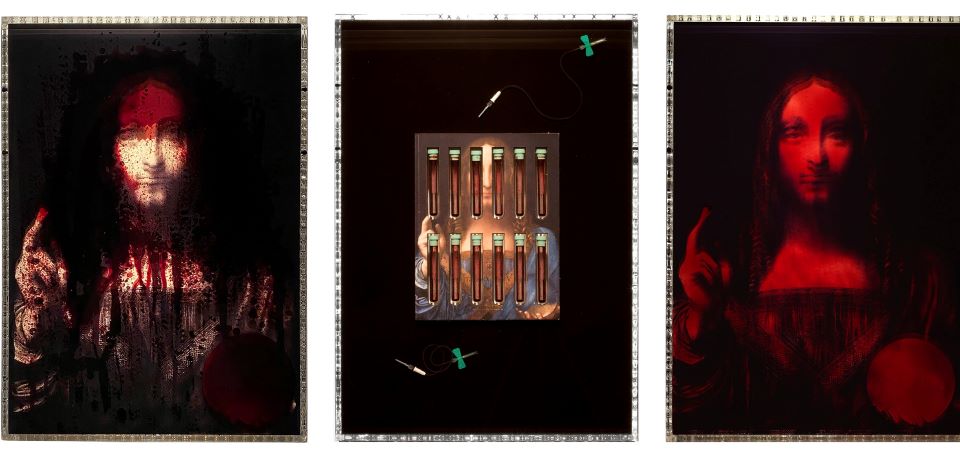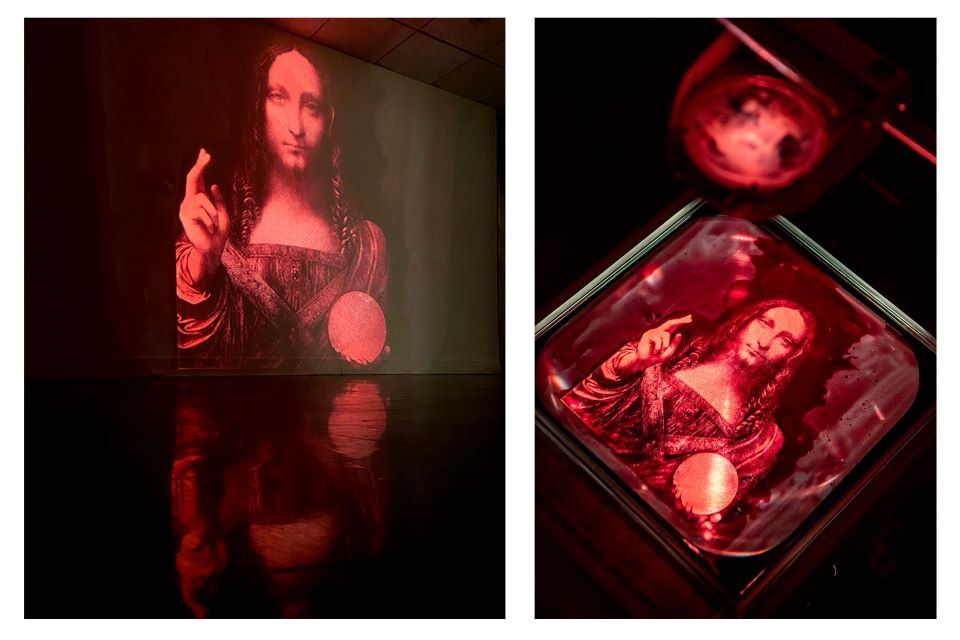MOCRA Presents Art That Asks: What Is Viral? What Is Value?
The Museum of Contemporary Religious Art presents Jordan Eagles: VIRAL\VALUE, an exhibition of works made from images of the disputed painting Salvator Mundi and the donated blood from an HIV+ undetectable, long-term survivor and activist.
ST. LOUIS (October 26, 2022) - On Nov. 15, 2017, a painting attributed to Leonardo da Vinci—Salvator Mundi (Savior of the World)—was sold at auction at Christie’s New York for an astronomical hammer price of $450,300,000, making it the most expensive artwork in history. Five years later, the work continues to generate speculation.
Experts still disagree whether it was painted by Leonardo. The work, rumored to have been bought by a proxy for Saudi Arabian Crown Prince Mohammed bin Salman, has not been seen in public since the auction, but recent reports suggest Saudi Arabia is building an art gallery to house the painting.
Artist Jordan Eagles saw something in Salvator Mundi beyond the controversy. Now, the Museum of Contemporary Religious Art (MOCRA) at Saint Louis University presents Jordan Eagles: VIRAL\VALUE, an exhibition that brings together for the first time five works by Eagles that combine the Salvator Mundi image with blood donated by an HIV+ undetectable, long-term survivor and activist.
“The works in VIRAL\VALUE are equal parts startling and subtle, steeped in scrupulous attention to religious and political discourses around health,” said Aaron Rosen, Ph.D., a co-curator of the exhibition. “They function as ethical and theological inquiries into the types of blood, bodies, and love that we value and venerate.”
The central work, Jesus, Christie’s, transforms the catalog from the Christie’s auction into a reliquary to hold twelve blood collection tubes and needles from layered with blood from an HIV+ undetectable, long-term survivor and AIDS activist. Two companion works, Vinci and Vinci II, feature grayscale images of Salvator Mundi layered with the same donated blood. All three works are the same size as the Renaissance masterpiece; the catalog, blood, and medical waste are all fully preserved in a high-gloss, reflective resin.
The exhibition also includes the installation Vinci (Illumination), an analog light projection into one of the museum’s side chapel galleries, transforming the space and the visitors who enter it. Vinci (Donor Portrait), a poster – complimentary for all visitors – is a collaboration between Eagles and What Would an HIV Doula Do? (WWHIVDD). One side of the poster features a photo of the Eagles work Vinci taken by the activist whose blood is incorporated into the artwork. A close look reveals the activist’s hands and phone taking the picture. The other side includes a text by writer, poet, and musician Bryn Kelly, as well as two questions posed by WWHIVDD: What is Viral? What is Value? Visitors to the exhibition are invited to take a poster to display, share, and stimulate conversations.
VIRAL\VALUE highlights a number of challenging contradictions. As Salvator Mundi demonstrates, the art world struggles with questions of malpractice and distorted values. Similar dynamics occur in the realm of healthcare. Stories can be contagious and transmissible, from the shared myths and histories that bind communities to intentionally harmful misinformation that demonizes vulnerable populations. In the case of pandemics such as AIDS and COVID-19, the virality of misinformation exposes our social and moral frailties even as viruses expose our bodies’ vulnerabilities. Sophisticated COVID-19 vaccines were developed in record time, but many people refuse to receive them. The latest HIV treatments keep viral loads undetectable, making the disease untransmissible, but U.S. blood donation policies exclude gay and bisexual men categorically, rather than according to behavioral risk factors.
Noting the Christian belief that Jesus Christ shed his blood for all humanity, Eagles suggests that Christ might be considered the world’s greatest blood donor of all time. If so, what do we make of almost half a billion dollars being spent on a likeness of Christ: does the value represented by money spent align with professed values? Eagles’ work prompts us to listen broadly and attentively to the experiences of others, reflect deeply on our personal and collective values, and work against discrimination.
“We are pleased to be showing Jordan’s work, not only for its aesthetic and conceptual power, but also for the conversations it will generate,” said David Brinker, MOCRA director and exhibition co-curator. “It is fortuitous that VIRAL\VALUE will be on display on December 1, when we mark World AIDS Day and Day With(out) Art. Beginning with MOCRA’s groundbreaking 1994 exhibition Consecration: The Spiritual in Art in the Time of AIDS, the museum has highlighted the way that artists respond to complex and fraught issues that challenge communities and have deeply personal impacts on individuals.”
Jordan Eagles: VIRAL\VALUE opens at MOCRA on Oct. 26 and continues through Dec. 18. More information is available at slu.edu/mocra. The exhibition is co-curated by MOCRA Director David Brinker and Rosen, a professor of religion & visual culture and the director of the Henry Luce III Center for the Arts & Religion at Wesley Theological Seminary. VIRAL\VALUE will travel to the Henry Luce III Center for the Arts & Religion in Washington, D.C., in spring 2023.
About the Artist
Jordan Eagles (b. 1977) has been exploring the aesthetics and ethics of blood as an artistic medium since the late 1990s. Eagles' works are held in numerous private and public collections including the Everson Museum of Art, Peabody Essex Museum, Princeton University Art Museum, Rose Art Museum, University of Michigan Museum of Art, Wellcome Collection, Henry Luce III Center for the Arts & Religion, and MOCRA. Recent exhibitions, installations, and public programs include The Andy Warhol Museum (Pittsburgh, PA), Leslie-Lohman Museum of Art (New York, NY), Museum of the City of New York, Birmingham Civil Rights Institute (Alabama), The High Line (New York, NY) and Hammer Museum (Los Angeles, CA). Eagles has collaborated with the NYC Department of Health and Mental Hygiene on NYC Blood Sure and—in partnership with GMHC and FCB Health—is a co-founder of Blood Equality. Eagles lives and works in New York City. More information at jordaneagles.com.
About MOCRA
Saint Louis University’s Museum of Contemporary Religious Art (MOCRA) is the first museum to bring an interfaith focus to contemporary art. Officially opened in 1993, MOCRA is located in a spacious chapel that was used for over 35 years by Jesuits studying philosophy at Saint Louis University. Through exhibitions, collections, and educational programs, MOCRA highlights and explores the ways contemporary visual artists engage the religious and spiritual dimensions. MOCRA serves the diverse Saint Louis University community, and the wider public, by facilitating personal discovery, experience, and inspiration, while contributing to a wider culture of interfaith encounter and dialogue.
MOCRA is located at 3700 West Pine Blvd. on the campus of Saint Louis University. Museum hours are Wednesday, Friday, Saturday, and Sunday, from 11 a.m to 4 p.m., and Thursday from 11 a.m. to 7 p.m. Admission is free. For more information, call 314-977-7170 or visit slu.edu/mocra.
About the Henry Luce III Center for the Arts & Religion
The Henry Luce III Center for the Arts & Religion is located at the heart of Wesley Theological Seminary’s sweeping, hillside grounds in northwest Washington, D.C. The center has been a national leader in research, teaching, outreach, and exhibitions in its field for over 30 years. It is home to the Arthur & Marjorie Dadian Gallery, featuring contemporary art exhibitions open to the public every weekday, free of charge. The Luce Center’s permanent collection is on exhibition throughout the campus and ranges from ancient Near Eastern artifacts to Reformation Bible manuscripts to works by major modernists such as Georges Rouault and Louise Nevelson. Each year, the center hosts a creative-in-residence in its expansive on-campus studio, with a focus on supporting diverse emerging and mid-career artists engaging with spiritual themes and questions. More information at luceartsandreligion.org.



















